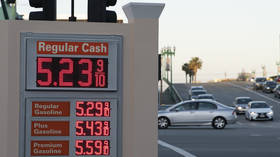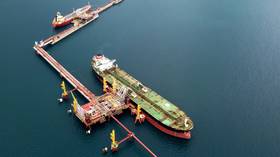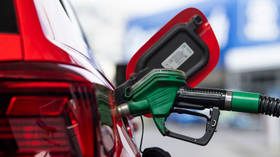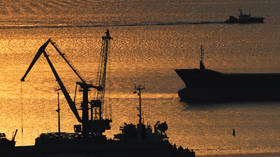Alexey Grivach: With soaring energy prices, the specter of stagflation haunts the world

The surge in energy prices, which began last year and has been reinforced by Russia’s military action in Ukraine and the “collective West’s” sanctions war against Moscow, has brought the world back to the 1970s.
That was a time when stagflation raged – first in Britain and then in other countries across the globe.
“As we look at global GDP… it’s hard right now to see how we avoid a recession,” World Bank President David Malpass told an event organised by the US Chamber of Commerce in late May. “The idea of energy prices doubling is enough to trigger a recession by itself.”
The week before, on the sidelines of the G7 finance ministers' meeting, US Treasury Secretary Janet Yellen acknowledged that “higher food and energy prices are having stagflationary effects, namely, depressing output and spending and raising inflation all around the world.”
Stagflation is a contradiction from the point of view of classical economic theory, combining a sharp rise in prices and a slowdown in GDP growth. The term is attributed to Ian McLeod, a British Conservative politician who was never an economist but rather a poet, an avid bridge-player, a fine orator and who served as Health Secretary under Winston Churchill, Labour Secretary under Anthony Eden and Secretary of State for the Colonies under Harold Macmillan.
In 1965, as shadow Chancellor of the Exchequer, he said in a speech to the House of Commons: “We now have the worst of both worlds – not just inflation or just stagnation, but both. We have a kind of ‘stagflation’ situation.” However, the term gained real international fame after MacLeod’s death, in the mid-1970s, when the developed economies faced an Arab oil embargo due to the supply of weapons to Israel during the Yom Kippur War with Egypt and Syria.
Back then, due to a supply cut-off to the US, Japan, Canada and Western European countries, OPEC production dropped by 25%, global oil prices immediately quadrupled, and importing countries experienced severe fuel shortages and were forced to introduce various austerity measures, from fuel rationing to the introduction of speed limits for motor vehicles. Although the embargo was lifted five months later, oil prices continued to rise throughout the 1970s, undergoing another massive leap (two and a half times) at the end of the decade after the Islamic Revolution in Iran. Thus, the nominal price of crude rose by an order of magnitude during the 1970s, creating a new economic and political reality.
What is happening now is very similar to the events of 50 years ago. However, this time an embargo on Russian energy supplies is being attempted by the consumers themselves, the same ones supplying military aid to the Ukrainian government. Incidentally, one of the consequences of the oil crises of the 1970s was the emergence of large gas pipelines from the Soviet Union to Western European states, which were seeking to reduce their dependence on Arab supplies.
At that time, projects to build LNG terminals in the Arctic to supply Soviet LNG to the US were also on the agenda, with the same aim of increasing energy security through diversification of suppliers. However, the détente in Soviet-American relations ended before it had even started, and in the early 1980s the Reagan administration fiercely fought against the construction of the Urengoy-Pomary-Uzhgorod gas pipeline, or, as it was called in the US media and official documents, the “Siberian gas pipeline,” to deliver large volumes of gas from Western Siberia to Germany, France, Italy and Austria.
In general, of course, history has a tendency to repeat itself. But there are some striking differences. The fact is that energy prices began their rally long before the previously “frozen” conflict in the Donbass turned hot and Moscow was battered by sanctions from Brussels and Washington.
In the fourth quarter of 2020, Brent crude was just over $44 per barrel, and in the last quarter of 2021, it was almost $80, growth of 80%. Accordingly, the price of a gallon of gasoline in the United States increased by 89% – from $1.25 to $2.36 (EIA data for the FOB price of Regular gasoline in the New York Bay area). The spot price of gas at the American Henry Hub also increased by 89%, to $172 per thousand cubic meters ($4.77 per million British thermal units), although this index has not shown any correlation with the price of oil and gasoline for many years.
But all this pales in comparison to what has been happening with energy prices in the EU over the past year. The average spot price for gas (at the Dutch TTF hub) in the fourth quarter of 2021 was $1,160 per thousand cubic meters. And that is six times or 607% more than in the October to December period of 2020. The price of imported thermal coal delivered to northwest European ports increased by two and a half times (or 241%) – from $66 to $160 per ton. And the cost of electricity (the day-ahead spot price in base load) in the UK, for example, jumped almost four and a half times or 439%, from £50 to £222 per MWh. This is not just energy inflation, but hyperinflation.
Moreover, the impact of the Ukrainian crisis on energy prices has been very modest. In the first quarter of 2022, oil, gasoline and imported coal tariffs continued to rise in the EU. Brent crude oil, on average, exceeded $100 (up 26% on the fourth quarter of 2021), US gasoline added 19% and coal prices in Europe rose 41% amid an EU embargo, though it was postponed until August. But gas prices did not rise in the first quarter, either in the US or Europe, and electricity in the UK was even slightly cheaper, by 4%. At the same time, the upward trend was maintained over the same period last year.
Meanwhile, in the US, gas prices rose sharply since April due to slow production growth, depleted storage and high demand from LNG plants, from which gas was mostly supplied to the EU. As a result, gas at the Henry Hub in the US was two-and-a-half times more expensive in April than a year ago, and 2.7 times more expensive in May.
Given that spot prices in the US are directly linked to prices for power plants, industrial consumers and commercial customers (i.e. the entire market volume, except for households, which account for only 17% of the 780 billion cubic metres of total demand), a two-to-threefold increase in gas prices is a heavy burden on the entire US economy. This is despite the fact that Washington has been a net exporter of the fuel for a couple of years now.
The Americans have promised to supply the whole world, including much of Europe, but they have failed to ensure that they maintain a comfortable level for themselves in times of need. Of course, the situation there is better than in Europe, where gas prices were already two to three times higher and have now jumped another five to six times. But the EU market after Brexit is 90% import-dependent, and for the bloc this price increase is an extra reason to advocate a rejection of hydrocarbons “at any cost.”
As a result, inflation in the US reached a 41-year high of 8.5% in March, in the UK 7%, something not seen in 30 years, and in the EU in April, 7.5% on average for the bloc (a year ago it was 1.6%). Moreover, five of the 27 members reached double-digit growth, while the absolute leader – Estonia-saw a 19% increase in prices.
And all of these delights were already in place for the EU and US economies before the situation in Ukraine escalated. A full embargo on Russian energy is still a long way off, but difficulties with logistics and the production of related goods, such as fertilizers, are already starting to emerge and will intensify for the foreseeable future, driving up inflation, fuelling fears of energy shortages and triggering a slowdown of economic growth.


















